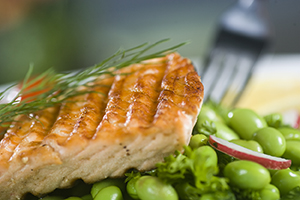5 Steps for Eating Healthier
Changing the way you eat can improve your health. It can lower your cholesterol and blood pressure, and help you stay at a healthy weight. Your diet doesn’t have to be bland and boring to be healthy. Just watch your calories and follow these steps:

Step 1. Eat fewer unhealthy fats
-
Choose more fish and lean meats instead of fatty cuts of meat.
-
Skip butter and lard, and use less margarine. Replace these with healthier fats, such as olive, canola, or avocado oils.
-
Pass on foods that have palm, coconut, or partially hydrogenated oils.
-
Eat fewer high-fat dairy foods like cheese, ice cream, and whole milk.
-
Get a heart-healthy cookbook and try some new recipes.
Step 2. Go light on salt
-
Keep the saltshaker off the table.
-
Limit high-salt ingredients, such as soy sauce, bouillon, and garlic salt.
-
Instead of adding salt when cooking, season your food with herbs, spices, and other flavorings. Try lemon, garlic, onion, vinegar, or salt-free herb seasonings.
-
Limit convenience foods, such as boxed or canned foods and restaurant food.
-
Read food labels and choose lower-sodium options. Buy fresh, frozen, or canned vegetables that don't have added salt.
Step 3. Limit sugar
-
Pause before you add sugars to pancakes, cereal, coffee, or tea. This includes white and brown table sugar, syrup, honey, and molasses. Cut your usual amount by half.
-
Swap out sugar-filled soda and other drinks. Buy sugar-free or low-calorie beverages. Remember, water is always the best choice. Try adding lemon juice to water for extra flavor.
-
Read labels and choose foods with less added sugar. Keep in mind that dairy foods and foods with fruit will have some natural sugar.
-
Cut the sugar in recipes by 1/3 to 1/2. Boost the flavor with extracts like almond, vanilla, or orange. Or add spices such as cinnamon or nutmeg.
Step 4. Eat more fiber
-
Eat fresh fruits and vegetables every day.
-
Boost your diet with whole grains. Go for oats, whole-grain rice, and bran.
-
Add beans and lentils to your meals.
-
Drink more water to match your fiber increase to help prevent constipation.
Step 5. Pay attention to serving sizes
-
Remember that a serving size is a standard measurement. It will let you track the amount of fat, calories, and other nutrients in the food you eat.
-
Read the Nutrition Facts label on packaged foods to learn their serving sizes.
-
Use serving sizes to assess how much food you put on your plate. Pay attention to your portions. How many servings are you eating?
-
Keep in mind that your needs may change if you’re more active or less active, or if you have other factors that change your calorie needs.
-
Use your hand to help you measure serving sizes. For example:
-
1 teaspoon: This is about the size of the first joint of your thumb.
-
1 tablespoon: This is about the size of the first 2 joints of your thumb.
-
1 ounce: This is about what you can fit in your cupped hand.
-
2 to 3 ounces: This is about the size of the palm of your hand.
-
½ cup: This is also about what you can fit in your cupped hand.
-
1 cup: This is about the size of your fist.
© 2000-2024 The StayWell Company, LLC. All rights reserved. This information is not intended as a substitute for professional medical care. Always follow your healthcare professional's instructions.